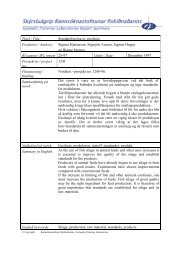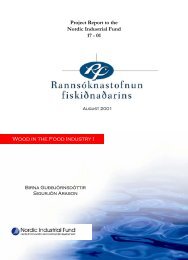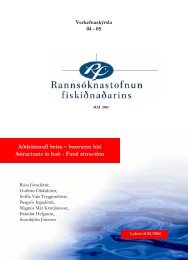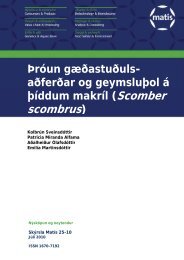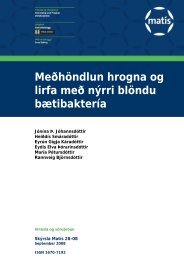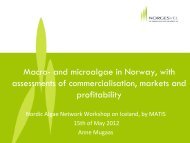Microbiology and Spoilage Trail in Nile Perch (Lates niloticus), Lake ...
Microbiology and Spoilage Trail in Nile Perch (Lates niloticus), Lake ...
Microbiology and Spoilage Trail in Nile Perch (Lates niloticus), Lake ...
Create successful ePaper yourself
Turn your PDF publications into a flip-book with our unique Google optimized e-Paper software.
ice there was only a small marg<strong>in</strong> (different) of about 1 log10 cfu/cm 2 <strong>in</strong> both parameters on<br />
the sk<strong>in</strong> prior to wash between the three factories (establishments). The levels of TVC counts<br />
reflect that whole fish was stored <strong>in</strong> ice for considerably time. In accordance with ICMSF,<br />
(1986), normal micro flora counts on the sk<strong>in</strong> of fish at the time of harvest are <strong>in</strong> the region<br />
of 10 2 – 10 5 organisms per gram while an <strong>in</strong>crease to levels of > 10 6 per gram <strong>in</strong>dicates long<br />
storage <strong>in</strong> ice (chill conditions). Dur<strong>in</strong>g storage <strong>in</strong> ice, the bacteria loads, blood <strong>and</strong> slimes<br />
on sk<strong>in</strong> are cont<strong>in</strong>uously washed away by melt<strong>in</strong>g ice. The Total viable counts (prior-wash)<br />
<strong>in</strong> this study are with<strong>in</strong> the range reported by Adams <strong>and</strong> Moss (2008); Shewan (1962);<br />
ICMSF (1980b); <strong>and</strong> Liston et al., (1976); that, the bacterial loads on the sk<strong>in</strong> of fish from<br />
catch can range from hundreds up to millions per square centimetres (10 2 -10 7 numbers/cm 2 )<br />
of sk<strong>in</strong>. Gibson <strong>and</strong> Ogden, 1987; <strong>and</strong> Dalgaard <strong>and</strong> Huss, 1994), showed that the slow<br />
<strong>in</strong>crease <strong>in</strong> counts may be caused by effect of ice where by it retards the growth of<br />
microorganisms to less than one-tenth of the rate at optimal growth rates. While compared<br />
with the relative growth rate of microorganisms at 20-30 o C which is approximately 25 times<br />
higher than at 0 o C. The effect of wash<strong>in</strong>g whole fish on reduc<strong>in</strong>g bacterial loads was more<br />
significant for Enterobacteriaceae than for total viable counts. There were more than 1 log10<br />
cfu/cm 2 decreases after wash <strong>in</strong> Enterobacteriaceae at all three establishments but only <strong>in</strong><br />
one establishment <strong>in</strong> TVC counts. Hence these results reveal a good bacteriological<br />
freshness quality of whole fish for process<strong>in</strong>g as the counts were with<strong>in</strong> the limits refered to<br />
previously.<br />
The results prior <strong>and</strong> after wash<strong>in</strong>g for onl<strong>in</strong>e fillets correspond<strong>in</strong>g to the above different fish<br />
lots <strong>and</strong> establishments show some difference between establishments. Counts prior to fillets<br />
wash<strong>in</strong>g were 2,91 – 4,55 log10 cfu/g (Enterobacteriaceae) <strong>and</strong> 5,49 – 6,27 log10 cfu/g (TVC).<br />
A guidel<strong>in</strong>e on TVC level for fresh fish <strong>and</strong> fish products microbiological quality <strong>in</strong>clud<strong>in</strong>g<br />
fillets is 5x10 5 -10 7 colony form<strong>in</strong>g units per gram (cfu/g) of muscle (ICMSF, 1986) <strong>and</strong> for<br />
Enterobacteriaceae ≤ 10 3 cfu/g of muscles (fillets). Accord<strong>in</strong>g to the results before wash<strong>in</strong>g,<br />
the counts <strong>in</strong> 2 establishments were above levels of 10 3 cfu/g <strong>and</strong> <strong>in</strong> all 3 establishments above<br />
5x10 5 cfu/g for Enterobacteriaceae <strong>and</strong> TVC respectively. This is <strong>in</strong>dicat<strong>in</strong>g a likely<br />
contam<strong>in</strong>ation <strong>and</strong> or growth of microorganisms dur<strong>in</strong>g the subsequent process<strong>in</strong>g steps at<br />
establishments. However after wash the microbiological loads for E2 <strong>and</strong> E3 <strong>in</strong> fillets were<br />
significantly reduced below the maximum allowable limits < 10 3 cfu/g (Ent.) <strong>and</strong>




